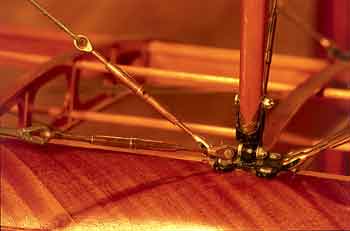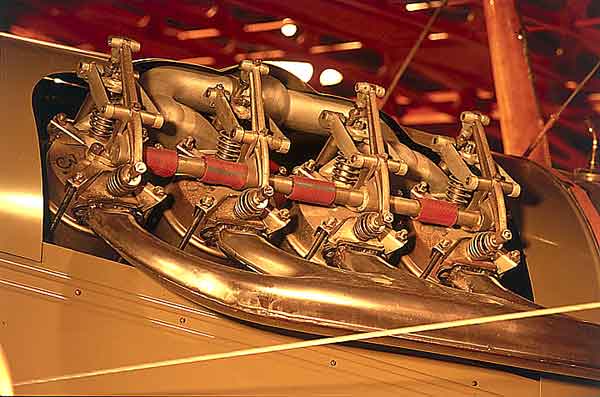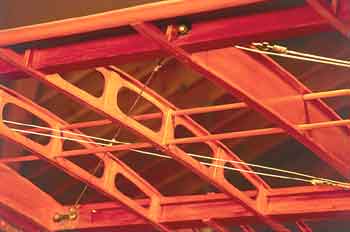PAGE THREE
Some Background on the Lady
It is interesting to think where the world would be without certain inventions that are as basic as dirt. Take the nail, for instance. Without it, civilization would quite literally fall apart. Wire is another of those inventions without which we'd be lost. Without wire there would be no telephone, no way of keeping cattle on their home on the range, no clothes hangers and, more importantly, no airplanes. Why no airplanes? Because without wire, the first generation of airplanes would have been placarded piles of disassociated pieces. It was wire that allowed those long-ago civil engineers cum airplane designers to build surprisingly light but huge structures that would allow man to fly on engines that had power-to-weight ratios worse than horses. The Curtiss Jenny was one of those structures.
 |
The airplane has miles of wire all connected
with turnbuckles. Photo stolen from John Dibbs/The
Plane Picture Co. |
Without wire, the legend of Jenny could not have been, because Jenny, the Curtiss JN-4D, was a three-mile ball of wire with some floppy surfaces mixed in to give it form. The question has often been asked whether the wire was there to tie the pieces of the Jenny together, or were the pieces there to keep the wires apart?
Jenny and all her wire were the acorn of aviation. To be sure, there were other airplanes, extremely important ones, before Jenny. But she was the final combination of controls and configuration that decided the future shape of airplanes. The joy stick with aileron and elevator, the rudder bar and throttle were all arranged exactly as we know them today. What's more important, Jenny made her contribution as an aviation pioneer because she was mass-produced and enough of her sisters were available to affect a complete generation of pilots -- the first generation of civilian, have-to-make-a-living, pilots.
Glenn Curtiss laid down Jenny's basic air frame in 1916, with an eye toward capturing a training contract from the fledgling air arm of the Signal Corps. Since he couldn't run out to Pennsylvania and scoop up an engine for his new airplane (there were no regular manufacturers), he designed and built his own engine. His 90-hp water-cooled OX-5 V-8 weighed a whopping 420 pounds -- hardly a light weight by today's standards, but it put out a fairly reliable 90 hp, and only quit occasionally. You had to take special care of the engine, like greasing the exposed rocker-arm assembly every few hours. But even with the best of care, Jenny seldom went more than 50 hours before an exhaust valve would warp, and you had to tear the engine down. A single airplane could have worn out a carload of engines in its life.
Probably the OX-5's biggest asset, at least as far as a penny-pinching generation of barnstorming pilots was concerned, was its availability. The military definitely believed there was safety in numbers, so they built dozens of engines for every airframe produced. Surplus engines were everywhere, but even if supply had been short, the OX was a tractor-simple machine that almost any farm boy could keep running, after a fashion.
"After a fashion..." is a hindsight judgment. In the early 1920s, the OX's reliability and the Jenny's flight characteristics were considered standard fare. Pilots had only the glamour machines of the Great War to compare to it. In those days, Jenny was it, she was all they had. She was cheap, she was easy, she was available. $200 bought a good Jenny. A case of Scotch bought a better one.
~~~~~~~~~~~~~~~~~~~~~~~~~~~~~~~~~~~~
"It was quickly found that the front pit of
a Jenny would hold two or three cases of
bootlegged booze, and she could be modified to carry even more."
~~~~~~~~~~~~~~~~~~~~~~~~~~~~~~~~~~~~
After the war, it seemed as if Jenny were everywhere. There was nothing she couldn't and didn't do. Her most famous exploits were at the hands of barnstormer pilots who wanted to eat more than they wanted to live. They'd do anything for a crowd, and they asked Jenny to do things for which she was never designed. The old CAB probably didn't keep much data about barnstormers, except who was killed, where and how. One bit of statistical information that would have been interesting is how many hours Jenny flew with men or women standing on her wings or dangling from her landing gear.
 |
The overall "gizmoness" of
a Jenny is awe inspiring because so much of her mechanical workings
are out where everyone can see them. Photo stolen from John Dibbs/The
Plane Picture Co.
|
The famous Black Cat squadron super
pilots specialized in bending the
physics of aerodynamics as far as they could be bent and bending the
rules of luck even further. The legacy of Jenny and the barnstormer
generation, with which she shared many an open wheat field, is a thousand
feet of film picturing some of the most harebrained stunts ever pulled. Not
satisfied with standing on the wing of a Jenny when she was doing her
feeble imitation of a loop, the daredevils would walk nonchalantly about
on top and between her wings. They would clamber down to the landing
gear, hanging from their knees just behind that huge propeller. They'd
work two Jennys close together and climb from one airplane to another,
all the time knowing their only safety lay in the strength of their hands. Only
a sissy used safety wires, and the parachutes of the day were much too
bulky to allow them the freedom of movement they demanded. Many
times the Jenny came down with fewer men on board than she took off with.
When it came time to put wings on Pony Express riders, it was Jenny they chose for a mount to carry the mail. Although she wasn't much faster than a train, she didn't have to follow the tracks and could go places a train never dreamed. At the same time, she had adventures that have kept writers busy for over fifty years. Weather hasn't changed all that much since Jenny carried the mail. The Plains States can still brew up a ten-mile-high thunderstorm that man has yet to conquer, and the Utica-Buffalo run in winter is a guarantee of icing wings, blowing snow and winds so fierce they knife right through aluminum. In a spruce and canvas kite, with helmet and goggles for protection and a schedule that had to be kept, the early mail pilots and their Jennys were far more daredevils than any who flew under a bridge or looped-the-loop with a wing rider. The unmerciful pounding they took in an effort to prove an unproven concept will probably never be adequately portrayed in literature or film. Like war, it loses the steely edge of terror when it is simply retold. It has to be lived.
The Prohibition era, in which Jenny found herself wearing civvies, gave her plenty of work. It was quickly found that the front pit of a Jenny would hold two or three cases of bootlegged booze, and she could be modified to carry even more. So quiet, backwoods meadows would often awake to the harsh, but soft voice of a straining OX-5, as it did its very best to life a man and some 100-proof over the trees and to a far-away consumer behind a locked door with a peek hole. Just say Jenny sent me.
 |
I hate skinny women whose ribs show like
Jenny's The Plane Picture
Co |
Under her dress of cotton, Jenny had a skeleton of wood, a very dainty one. Her fuselage was framed of pieces of spruce and ash no more than an inch and a half square. It was a spidery combination of long, thin femurs of wood, joined together with incredibly complex fittings of wire and more wire. To keep it light, they kept all the structural members to an absolute minimum, depending upon the life-giving wire to brace the members and give them rigidity.
Even control surfaces, such as the ailerons and elevators, were externally braced by wires running up to a stand-off that was jutting up from the main spar of each surface. Huge suspension towers rode atop the outer panel of each wing, the wires running from many points on the wing to the terminus at the top of the towers. Wires on the Jenny fought lift, they fought drag, they argued with gravity, they stiffened surfaces, they told the landing gear what its place in life was supposed to be. Wires fought to hold Jenny together... but Jenny had to fight to move all that wire forward. With 90 hp and a light load, Jenny was hard-pressed to maintain 70-75 mph in level flight. Today, a clean 65-hp Cub could run away and hide from it. But then, so could everything else. Of course, in 1917, they didn't HAVE anything else.